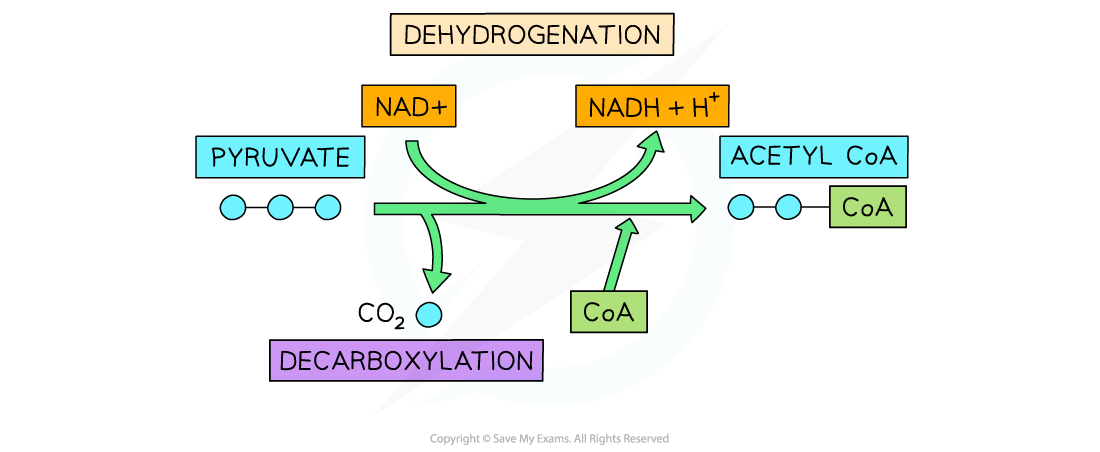Link Reaction
Entering the link reaction
- The end product of glycolysis is pyruvate (3C)
- Pyruvate contains a substantial amount of chemical energy that can be further utilised in respiration to produce more ATP
- When oxygen is available pyruvate will enter the mitochondrial matrix and aerobic respiration will continue
- Once in the matrix pyruvate takes part in the link reaction
The link reaction
- The link reaction takes place in the matrix of the mitochondria
- It is referred to as the link reaction because it links glycolysis to the Krebs cycle
- The steps are:
- Oxidative carboxylation reaction in which:
- Carbon dioxide is removed to produce a 2C molecule
- This 2C molecule is then oxidised (loss of hydrogen and 2 high energy electrons) to produce an acetyl compound and thereby reducing NAD to NADH
- Combination of the acetyl compound with coenzyme A to form acetyl coenzyme A (acetyl CoA)
- Oxidative carboxylation reaction in which:
- It produces:
- Acetyl CoA
- Carbon dioxide (CO2)
- Reduced NAD (NADH)
pyruvate + NAD + CoA → acetyl CoA + carbon dioxide + reduced NAD
- Acetyl coenzyme A is supplied to the Krebs cycle where aerobic respiration continues

The link reaction occurs in the mitochondrial matrix. It dehydrogenates and decarboxylates the three-carbon pyruvate to produce the two-carbon acetyl CoA that can enter the Krebs Cycle.
Exam Tip
Remember that there are two pyruvate molecules produced per glucose molecule so you need to multiply everything by 2 when thinking about what happens to a single glucose molecule in aerobic respiration.
Krebs Cycle
- The Krebs cycle (sometimes called the citric acid cycle) consists of a series of enzyme-controlled reactions
- The Krebs cycle takes place in the matrix of the mitochondria
- Two carbon (2C) Acetyl CoA enters the circular pathway from the link reaction
- A four carbon compound (4C) accepts the 2C acetyl fragment from acetyl CoA to form a six carbon compound (6C)
- Coenzyme A is released in this reaction to be reused in the link reaction
- The 6C compound is then converted back to the 4C compound through a series of oxidation-reduction (redox) reactions

The Krebs Cycle uses acetyl CoA from the link reaction to produce reduced carbon dioxide, reduced NAD, reduced FAD and ATP
The reactions involved in the Krebs cycle
- The 4C compound is regenerated in the Krebs cycle through a series of redox reactions
- Decarboxylation of the 6C compound
- Releasing two CO2 as waste gas
- Oxidation (dehydrogenation) of the 6C compound releases hydrogen atoms
- Reduction of coenzymes NAD and FAD (by the released H atoms)
- 3 NAD+ and 1 FAD → 3NADH + H+ and 1 FADH2
- Substrate-level phosphorylation
- A phosphate is transferred from one of the intermediates to ADP, forming one ATP
- As the link reaction produces two molecules of acetyl CoA (one per each pyruvate), the Krebs cycle occurs twice
- Per glucose molecule, the Krebs cycle produces:
- 4 CO2
- 2 ATP
- 6 NADH + H+ (reduced NAD)
- 2 FADH2 (reduced FAD)
Exam Tip
The Krebs cycle is often referred to as cyclical or circular. This is because the 4C acceptor molecule is regenerated throughout the reaction so that it can start all over again by adding another acetyl CoA.
The names of the intermediate molecules in the Krebs cycle and the link reaction are not required.